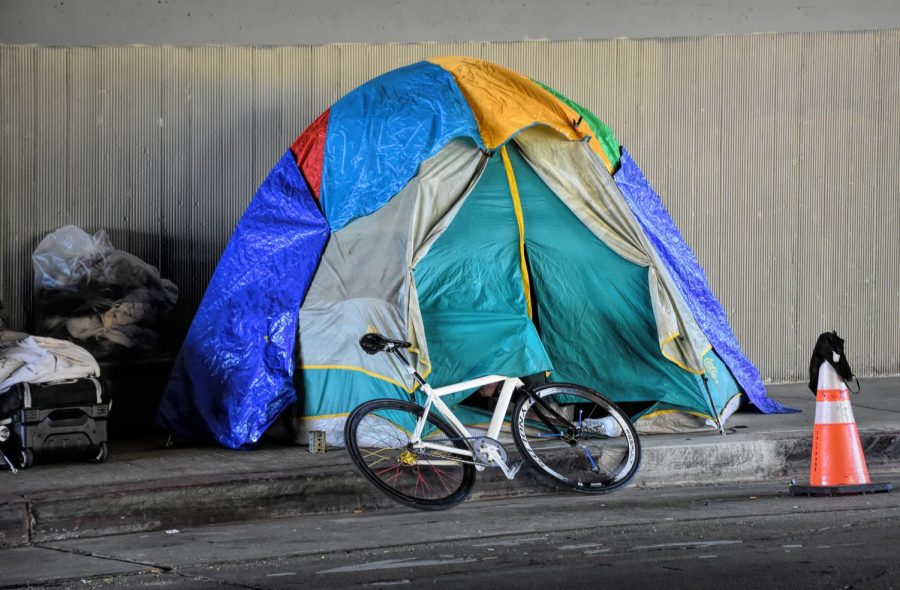Ritenour works to help students who become homeless
Chris Yarzab under Creative Commons license
Homelessness is a problem in the United States, and a large number of St. Louis youth are affected by the problem. Ritenour has a system in place to help those students who deal with this hardship.
May 19, 2021
Homelessness is closely related to but does not equal poverty.
A common misconception is that those who are homeless are financially irresponsible and that the individual is always at fault for their circumstance. In reality, there are infinitely many ways in how a person may end up displaced or homeless. The social stigmas surrounding poverty and homelessness make it that much more difficult, particularly for teens facing homelessness, to speak up and seek out help.
The federal government defines homeless youth as people under age 25 who are living without a parent or legal guardian. The average age of a homeless person in the US is just 11 years old. Data collected by the National Conference of State Legislatures (NCSL) shows homelessness affects an estimated 4.2 million minors and young adults yearly. An estimated 1 in 30 experience homelessness between the ages of 13-17.
The overall homeless population in the Saint Louis County area increased by 18 percent in 2020, equating to about 1 in every 386 residents being without permanent housing. These numbers have been exacerbated by economic impacts and housing instability associated with the COVID-19 pandemic.
“In light of the pandemic, many families are going through hardships. This alone has brought prevalent issues to a topic that is underrepresented.” Ritenour High School Crisis Intervention Specialist Keaton Strong said.
In the St Louis County area, there are a total of 11 crisis centers and shelters accepting youth, all of which have a maximum of 30 to 45 days for emergency housing. These practices raise the question of how this time would be enough for an unaccompanied minor to change anything about their housing situation without significant support.
Here, an all too common situation can occur, resulting in those who rely on the system rotating from shelter to shelter. The importance of access to resources and long-term support can very well make the difference between a student being temporarily displaced and suffering chronic homelessness.
“Resources are not easily available, but they are available. It requires several phone calls and contacts to get the resources, but again the Crisis Intervention Specialist at Ritenour coordinates services for those in need. The services are used more than many would think,” Strong said.
Within the Ritenour School District, students have the ability to contact the Crisis Intervention Specialists for assistance with housing services, their grade level counselor, or the Assistant Superintendent who is in charge of Housing Coordination-Student Services.
One of the difficulties when organizing a response to youth homelessness is ensuring that resources reach those in need.
“I think promoting that we have people within the district who work on things such as this to include social workers, case managers, and counselors,” Strong said.
Youth in marginalized groups are disproportionately affected by homelessness, as well as being taken advantage of and/or mistreated at a higher rate. Black, Hispanic, and Indigenous youth experience homelessness at higher rates, with LGBTQ+ youth of any race experiencing homelessness at a rate more than twice that of their peers. Key risk factors for youth homelessness are thought to be family conflict, mental health issues, and substance abuse, as identified through a report made by the Congress Research Service.
The social impacts are an aspect of youth homelessness that varies case by case. Because homelessness tends to be associated highly with poor attendance, academic performance, and juvenile delinquency, it is not uncommon that students experiencing homelessness may hide their situation to escape stereotyping, social isolation, or even retaliation by their peers.
“Some students prosper when they make do with what they have and socially they fit right in. Others have become withdrawn or have the feel of defeat,” Strong said. “All of our students have individual problems and we have to treat each issue as its own issue because no one issue is the entirety.”
No matter how well it is dealt with, the additional stresses and trauma caused by unstable housing can make for a situation that is difficult to speak about in any setting. Creating the right spaces for outreach, as well as understanding among the student body may relieve some of the negative pressures and stigmas that homeless and displaced students face.
“This is an issue that is never easy to talk about. I think once a student has an opportunity to talk with me or Mrs. Hahn they become at ease with having the discussion. We make all students and families feel welcomed and put out the fact that everyone goes through hardships, but you would never know one has a hardship if they do not speak about it,” Strong said.



